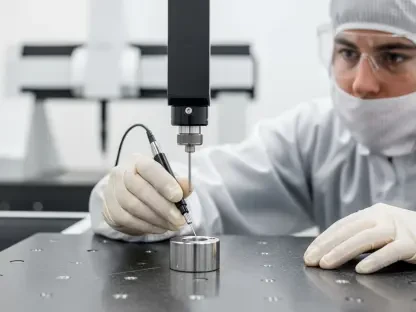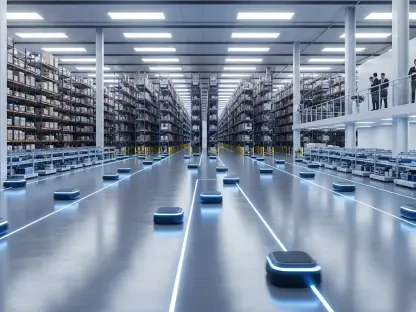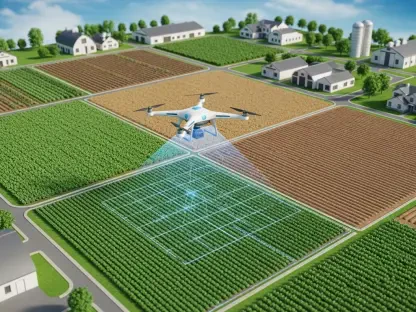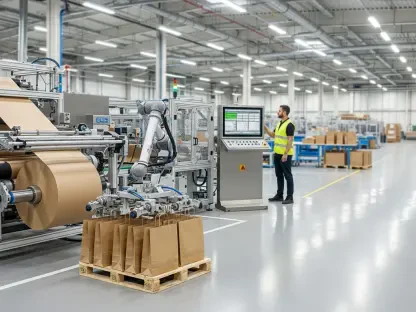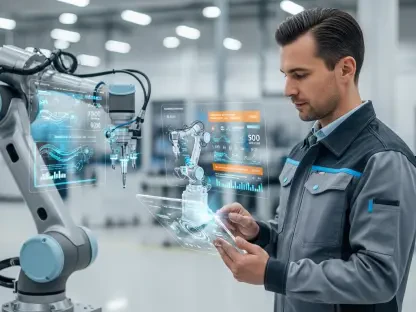In an era where manufacturing is defined by rapid technological advancements and unrelenting market pressures, the gap between data collection and actionable decision-making has become a critical bottleneck for industry leaders, hindering their ability to stay competitive. With 55% of supply chain executives ramping up technology investments and 42% committing over $10 million annually, as reported by a recent MHI Industry Report, the digital infrastructure in factories is more robust than ever. IoT sensors monitor equipment, POS systems track real-time demand, and supplier networks provide inventory updates. Yet, despite this wealth of information, production planning and scheduling (PPS) often lags behind, tethered to outdated spreadsheets and manual processes. This disconnect prevents manufacturers from leveraging data to ensure product quality, meet customer demand, and drive profitability. The solution lies in AI-driven PPS, a transformative approach that turns rigid, static systems into dynamic, intelligent tools capable of integrating sensory data into real-time execution. This shift promises not just operational efficiency but a fundamental reimagining of how factories respond to today’s volatile landscape.
1. Unpacking the Data-to-Action Challenge
The modern manufacturing environment is awash with data, generated from countless sources like machine health indicators and real-time market signals. However, the inability to convert this information into swift, strategic decisions remains a persistent hurdle. Traditional PPS tools, often rooted in static spreadsheets and prolonged planning cycles, struggle to keep pace with disruptions. Factories are left with untapped potential, as valuable insights become mere background noise rather than drivers of action. The issue is not a scarcity of data but the lack of responsive systems to process and prioritize it effectively. Without a mechanism to bridge this gap, manufacturers risk misaligned production, compromised quality, and diminished returns on their digital investments. AI-driven solutions offer a way forward by automating the translation of complex data streams into executable plans, ensuring that every signal contributes to tangible outcomes.
This challenge is compounded by the sheer volume of information that factories must handle daily. From demand fluctuations to equipment performance metrics, the deluge of data can overwhelm even the most dedicated teams. Manual workflows exacerbate the problem, as planners spend excessive time on routine tasks rather than strategic analysis. The result is a reactive rather than proactive approach, where opportunities are missed, and inefficiencies persist. AI-powered PPS addresses this by filtering out irrelevant noise and focusing on critical signals that demand immediate attention. By embedding intelligence into planning processes, manufacturers can shift from firefighting to forecasting, aligning production with real-time conditions and market needs. This transformation is not just a technological upgrade but a necessary evolution for staying competitive in a fast-paced industry.
2. Navigating Key Manufacturing Hurdles
Manufacturers face a myriad of challenges that underscore the urgency of modernizing PPS. Demand volatility tops the list, as consumer preferences shift rapidly, often leaving production based on outdated assumptions. This misalignment, known as the ‘signal decay effect,’ leads to waste, service failures, and operational ripples across the supply chain. Additionally, global supply chain shocks—whether from pandemics, crop failures, or geopolitical tensions—expose the fragility of static planning, resulting in missed orders and excess inventory. Sustainability pressures further complicate the landscape, as environmental goals clash with profitability in legacy systems unable to balance waste reduction with service levels. Scaling bottlenecks and technology investments without clear ROI round out the struggles, with manual processes hindering growth and organizational resistance stalling tech adoption.
These issues are interconnected, creating a vicious cycle of inefficiency. For instance, unpredictable demand amplifies supply chain vulnerabilities, while sustainability mandates add layers of complexity to already strained planning systems. Scaling operations becomes a costly endeavor when labor shortages and manual tasks dominate workflows, and even significant tech investments falter without stakeholder trust in autonomous solutions. The cumulative effect is a manufacturing sector caught between ambitious goals and outdated tools. AI-driven PPS emerges as a critical intervention, offering the agility to adapt to demand shifts, the resilience to withstand disruptions, and the precision to align sustainability with financial objectives. By addressing these pain points holistically, such systems pave the way for operational excellence.
3. Closing Gaps with AI-Enabled PPS
AI-driven PPS directly tackles the operational roadblocks that hinder manufacturing efficiency, starting with the problem of data overload. Modern factories generate thousands of data points hourly, from demand forecasts to supply alerts. Yet, without intelligent filtering, critical signals get lost in the noise, leading to production misfires and missed opportunities. Advanced PPS solutions capture high-fidelity data like POS trends and weather patterns, prioritize actionable insights, and feed them into real-time production schedules. This capability has been shown to improve on-time delivery by up to 20%, ensuring the right products are available when customers need them. By transforming chaotic data into structured decisions, AI empowers factories to respond with precision and speed.
Real-world applications highlight the impact of these systems. Take the case of Atria, a leading food company in Northern Europe specializing in perishable meat products. Facing the challenge of precise daily forecasting to avoid stockouts and spoilage, Atria implemented machine learning-driven PPS. The system automatically processed vast amounts of retail partner data, identifying sudden demand shifts and adjusting plans accordingly. The results were striking: a 98.1% weekly forecast accuracy and a 13% reduction in manual adjustments. This example underscores how AI can turn complex, fluctuating information into reliable production strategies, minimizing waste and enhancing service levels. Such outcomes are not isolated but represent a scalable model for manufacturers across industries aiming to bridge the data-to-action gap.
4. Tackling Supply Chain Volatility
Supply chain disruptions remain a defining challenge, with 50% of companies citing shortages as a top issue per the MHI Report. Global shocks, fluctuating input costs, and rigid planning cycles often break the link between plan and execution, leading to costly missteps like excess inventory and missed orders. Traditional schedules, updated weekly or monthly, cannot match the hourly pace of real-world changes. Constraint-aware planning, which adapts to operational limits in real time, offers a solution by reconfiguring production plans swiftly. This approach balances push planning, driven by available materials, with pull planning, responsive to demand signals, ensuring alignment with current realities rather than outdated assumptions.
A compelling example comes from Tegel Foods, a major player in New Zealand’s poultry market, processing over 50 million birds annually. Struggling with input variability and Excel-based planning, the company adopted constraint-aware PPS to optimize production across three facilities. The system provided weekly targets and daily demand breakdowns, enabling proactive shortage management and surplus utilization through promotions. This led to increased throughput, reduced waste, and improved margins by dynamically balancing supply and demand. Such adaptability is crucial in high-volume, high-variability settings where static schedules falter. By integrating real-time signals into execution, manufacturers can navigate volatility without sacrificing efficiency, turning disruptions into manageable challenges rather than crises.
5. Harnessing AI for Strategic Advantage
The manufacturing sector is poised for an AI surge, with 58% of supply chain companies planning investments over the next five years, according to the MHI Report. However, many initiatives stall at pilot stages, leaving operations reliant on guesswork and eroding forecast accuracy. Specialized AI, designed for specific planning challenges, offers rapid automation through tools like auto-scheduling and scenario planning, supported by scalable cloud platforms. Generative AI capabilities, such as conversational assistants, democratize insights by allowing users to explore scenarios via natural dialogue. Meanwhile, agentic AI autonomously solves complex problems, rerouting supplies during delays with minimal human input, boosting resource utilization by up to 25%.
MAAG Foods, Estonia’s leading meat producer, exemplifies the transformative power of these technologies. Managing over 300 SKUs with volatile seasonal demand, the company adopted AI-driven touchless forecasting to automate demand tracking and planning decisions. The outcome was a 96% rate of forecasts requiring no manual adjustments and a 22% boost in planning efficiency. This shift allowed planners to focus on strategic priorities rather than routine tasks, demonstrating how AI can redefine operational workflows. By integrating specialized, generative, and agentic AI into a unified platform, manufacturers gain market-ready solutions to predict, plan, and respond effectively. The technology to close the gap between AI potential and reality exists now, offering a competitive edge to those ready to embrace it.
6. Aligning Sustainability with Business Goals
Sustainability has evolved from a corporate buzzword into a core operational imperative, yet it often conflicts with tight margins and service level demands. Resource efficiency directly affects shelf-life management, regulatory compliance, and supply shock responses, all of which influence growth. Poor sustainability practices also risk brand reputation as consumers and investors prioritize environmentally responsible suppliers. Advanced PPS solutions turn this challenge into an advantage by simulating recipe alternatives for environmental impact and supply efficiency, rotating stock based on shelf life to prevent waste, and using reverse Bill of Materials to match orders to raw material needs. Such strategies have reduced waste by up to 30% while maintaining production quality.
Blount Fine Foods, a manufacturer of premium prepared foods, showcases the practical benefits of sustainable planning. Since adopting touchless forecasting, the company slashed finished goods waste by 35% across 1,500 SKUs and improved production efficiency by 2% through optimized scheduling. This approach minimized changeovers and maximized resource use, proving that sustainability and profitability can coexist. By linking sales forecasting to long-term service level impacts, planners gained the ability to strategize proactively, navigating constraints within the supply chain ecosystem. These results highlight how AI-driven tools can transform waste reduction into a measurable business win, aligning ecological commitments with financial performance in a competitive market.
7. Transforming PPS from Static to Dynamic
Traditional PPS, rooted in static spreadsheets, locks manufacturers into inflexible schedules that crumble under disruption, with siloed decisions and costly changeovers draining efficiency. In contrast, AI-enabled PPS delivers dynamic, real-time optimization, continuously adjusting schedules based on evolving constraints and demand shifts. Autonomous decision-making within predefined rules frees planners for strategic tasks, while intelligent sequencing groups similar products to slash changeover times. Factories evolve from isolated units into responsive, self-correcting systems, fully connecting demand signals to execution through unified platforms. This shift eliminates manual data transfers, ensuring coordinated supply chain decisions.
The difference in outcomes is stark. Where legacy systems result in bottlenecks and outdated plans, AI-driven approaches create interconnected digital nodes that detect upstream constraints and market changes, learning from execution data to refine accuracy. Production moves from a disconnected process to an ecosystem where every signal informs action, reducing downtime and enhancing throughput. This evolution is not merely technological but structural, redefining the factory as a proactive entity rather than a reactive one. Manufacturers adopting such systems gain the agility to handle volatility while preserving operational margins, setting a new standard for efficiency. The contrast between static and dynamic PPS illustrates the urgent need for modernization in an industry where adaptability is now a prerequisite for success.
8. Mapping the Path to AI-Powered Planning
Transitioning from manual to AI-powered PPS requires a strategic, phased approach to minimize disruption while delivering value. The first step involves assessing current planning maturity to establish a baseline and identify operational gaps. Next, mapping signal-response disconnects reveals where data fails to translate into swift production decisions. Aligning priorities with capabilities ensures that the most pressing challenges are tackled first, in line with broader business growth objectives. Finally, starting with focused pilots allows for quick demonstration of value, followed by rapid scaling of successful use cases across operations. This roadmap ensures a systematic evolution from clunky spreadsheets to intelligent orchestration.
Implementation must be deliberate and measurable to sustain momentum. Establishing clear KPIs upfront provides specific targets to guide progress at each milestone. Phased deployment focuses on delivering incremental improvements, avoiding lengthy cycles that risk stalling transformation. Continuous optimization support further ensures that systems adapt to changing needs, maintaining relevance over time. This structured approach mitigates the risk of organizational inertia, a common barrier to tech adoption, by building trust through tangible results. Manufacturers following such a path can modernize planning without overwhelming existing workflows, creating a foundation for long-term resilience. The journey to AI-driven PPS is not a leap but a series of calculated steps, each reinforcing the capacity to thrive amid complexity.
9. Building Resilience through Smart Factories
Volatility is an inescapable reality in manufacturing, but integrated sensing, planning, and execution can turn it into a manageable factor. Smart factories, powered by advanced PPS, achieve stability amid demand fluctuations by using dynamic scheduling to capture market opportunities while mitigating risks. Supply shocks lose their impact through multi-layer resilience, automatically switching suppliers or reformulating recipes to keep operations running. Waste reduction becomes a concrete outcome, with every production run optimizing freshness and financial performance for sustainable gains. Planners, freed from routine tasks by automation, elevate into strategists focused on high-value areas like supplier negotiations and competitive positioning.
The broader implications of this shift are profound. Factories transform into adaptive systems that not only withstand disruptions but leverage them for advantage, outpacing competitors stuck in rigid models. Stability, resilience, and sustainability converge to create operations that are as environmentally conscious as they are profitable. This interconnected approach ensures that critical signals are no longer lost but acted upon with precision, building a foundation for enduring success. Manufacturers embracing these next-generation solutions position themselves at the forefront of industry evolution, ready to navigate whatever challenges arise. The strategic core of the smart factory lies in its ability to unify data and action, offering a blueprint for thriving in an unpredictable landscape.
10. Reflecting on Transformative Steps Forward
Looking back, the journey of integrating AI-driven production planning and scheduling marked a pivotal shift for manufacturers grappling with data overload and operational inefficiencies. The adoption of intelligent systems bridged critical gaps, turning raw signals into precise execution and delivering measurable gains in efficiency, sustainability, and resilience. As past challenges like demand volatility and supply disruptions were addressed through dynamic, real-time solutions, the industry witnessed a redefined standard for operational excellence. Moving forward, the focus should center on scaling these proven strategies across broader operations while continuously refining AI capabilities to match evolving market needs. Manufacturers are encouraged to modernize their response mechanisms, leveraging advanced tools to streamline processes and fortify against future uncertainties. The path ahead lies in sustained investment in adaptive technologies, ensuring that every factory evolves into a responsive, interconnected node ready to meet tomorrow’s demands with confidence.


